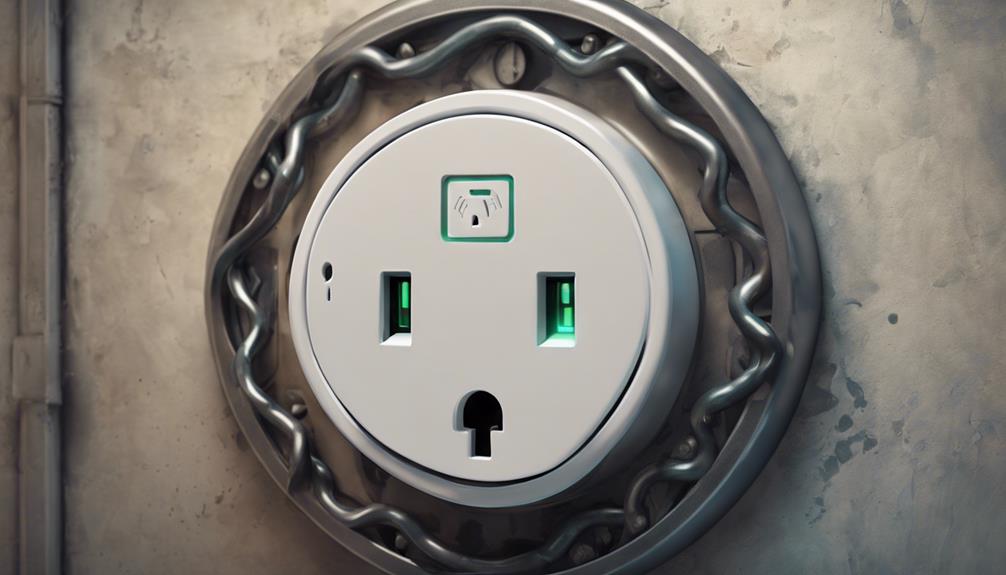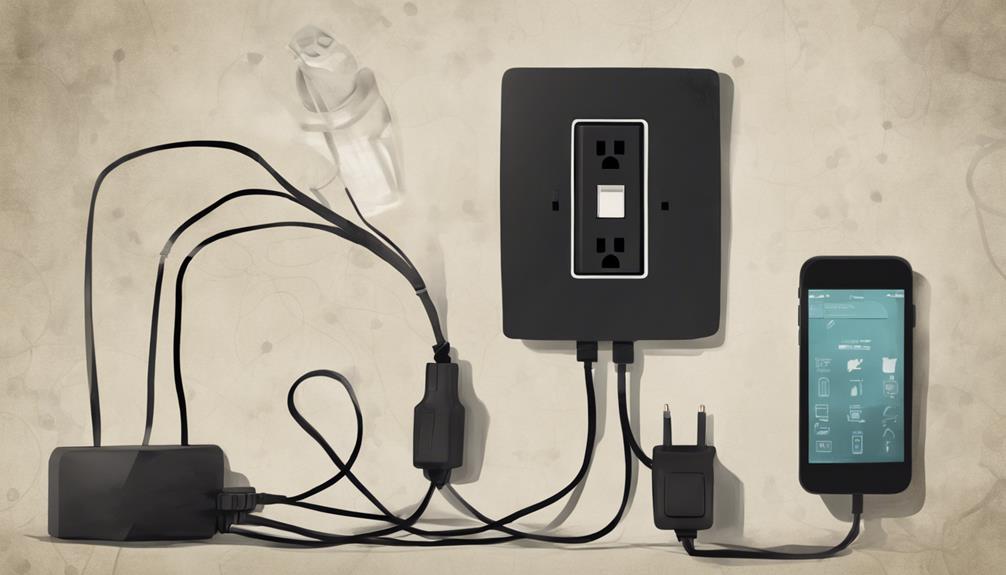Critical
Smart plugs, like Sonoff S26 and Ener-J WiFi, face security risks due to unencrypted communication and weak passwords, making them vulnerable to hackers. This exposes them to potential exploitation, compromising privacy and raising home security concerns such as unauthorized surveillance and manipulation of connected devices. Safeguarding against these threats requires addressing vulnerabilities, updating firmware regularly, and adopting strong password practices. Mitigation strategies like network segmentation can enhance security. Understanding the risks associated with smart plugs is critical for maintaining a secure environment. Protecting against cyber threats remains a top priority in IoT device security.
Key Takeaways
- Smart plugs are vulnerable to hackers due to unencrypted communication and weak passwords.
- Firmware updates are crucial for addressing security flaws in smart plugs.
- Implementing strong passwords and network security practices enhances safety.
- Unauthorized access can lead to control over devices and potential data breaches.
- Network segmentation and guest SSID setups can mitigate smart plug security risks.
Smart Plug Security Risks
Additionally, smart plug security risks are linked to vulnerabilities in devices like Sonoff S26 and Ener-J WiFi, primarily stemming from unencrypted communication and weak passwords. These security flaws expose smart plugs to potential exploitation by hackers seeking unauthorized access to home networks.
Once breached, hackers can compromise privacy by obtaining WiFi credentials, assuming control of devices, and engaging in illicit activities without detection. The implications for home security are significant, ranging from unauthorized surveillance to manipulation of connected devices, including those linked to essential systems like security alarms.
To mitigate these risks, proactive measures such as setting up a separate guest SSID for IoT devices and implementing network segmentation can help isolate critical devices from potential threats.
Timely response from manufacturers is crucial in addressing vulnerabilities promptly, safeguarding the security of smart plugs and the integrity of home networks.
Vulnerabilities in Smart Plug Communication

Smart plugs, such as Sonoff S26 and Ener-J WiFi, are at risk due to the lack of encryption in their communication protocols, making them susceptible to data breaches. These vulnerabilities enable hackers to potentially access WiFi credentials through weak factory passwords, raising concerns about remote unauthorized access to connected devices.
To mitigate these risks, regular firmware updates are essential to address security flaws promptly and safeguard users from potential cyber threats.
Data Security Risks
Data security risks associated with vulnerabilities in the communication of smart plugs have raised significant concerns regarding potential interception of data by hackers.
Smart plugs, such as Sonoff S26 and Ener-J WiFi, are susceptible to security flaws as they communicate over unencrypted HTTP, making it easier for hackers to access devices and compromise privacy.
The weak factory passwords implemented in these smart plugs further exacerbate the risks by providing attackers with a gateway to obtain WiFi credentials and infiltrate the network.
Once hackers exploit these vulnerabilities, they can remotely control connected devices, jeopardizing both home security and personal privacy.
This unauthorized access not only enables monitoring of activities but also opens the door to the manipulation of smart devices and potential exposure of sensitive data.
Consequently, criminals could exploit these vulnerabilities to determine occupants' absence, compromising home security systems and increasing the likelihood of physical break-ins.
Remote Access Concerns
Concerns regarding remote access vulnerabilities in smart plug communication have heightened due to the prevalent use of unencrypted HTTP traffic for data transmission. Smart plugs, such as the Sonoff S26 and Ener-J WiFi, are exposed to security flaws due to this lack of encryption, allowing hackers to intercept sensitive information.
The presence of weak factory passwords on these devices further exacerbates the risk, potentially enabling cyber attackers to extract WiFi credentials and infiltrate the home network without authorization. Exploiting these vulnerabilities, hackers could monitor user activities, manipulate smart devices, or access private data, posing significant threats to home security.
Firmware Update Importance
Addressing vulnerabilities in smart plug communication requires prioritizing the importance of firmware updates. Firmware updates play a critical role in ensuring the security of smart plugs by patching potential vulnerabilities that could be exploited by hackers seeking unauthorized access. Neglecting these updates can leave smart plugs susceptible to various cyber threats, compromising not only the device itself but also the entire network it is connected to. Manufacturers often release firmware updates to enhance encryption methods, authentication processes, and communication protocols, thereby strengthening the overall security posture of smart plugs. By regularly updating the firmware of smart plugs, users can mitigate the risks associated with hacking and unauthorized access, safeguarding their devices and networks from potential breaches.
| Importance of Firmware Updates | |
|---|---|
| Enhances Security | |
| Patches Vulnerabilities | |
| Mitigates Cyber Threats | |
| Strengthens Encryption | |
| Improves Authentication |
Mitigation Strategies for Smart Plugs

Implementing security best practices like setting up a guest SSID for IoT devices can help isolate smart plugs from critical network components.
By segregating networks and implementing network segmentation, users can enhance security measures and minimize unauthorized access risks.
Regular firmware updates are also essential to ensuring that smart plugs are equipped with the latest security patches to protect against potential vulnerabilities.
Security Best Practices
To enhance the security of smart plugs, it is essential to adhere to established best practices aimed at mitigating potential vulnerabilities and safeguarding against unauthorized access by hackers.
One critical measure is to implement strong, unique passwords for smart plugs to deter unauthorized access. Weak passwords can make smart plugs susceptible to being hacked, compromising both security and privacy.
Regularly updating smart plug firmware is another vital step to patch vulnerabilities and enhance security measures, ensuring that the devices are protected against evolving threats.
Additionally, setting up a separate guest Wi-Fi network for IoT devices like smart plugs can isolate them from critical devices, reducing the risk of unauthorized access.
Enabling two-factor authentication where possible adds an extra layer of security to smart plug access, making it harder for hackers to breach the system.
It is also important to monitor smart plug activity for any unusual behavior that could indicate a security breach or unauthorized access, allowing for timely intervention to prevent potential threats.
Firmware Updates
Regular firmware updates play a crucial role in fortifying the security of smart plugs against potential cyber threats and vulnerabilities. These updates are essential as they address security vulnerabilities within the smart plug's firmware that hackers could exploit to gain unauthorized access.
Manufacturers frequently release firmware updates to enhance the security features of smart plugs, ensuring they are protected against various cyber threats. Failure to promptly install these updates can leave smart plugs susceptible to hacking, potentially leading to unauthorized access to the device and the connected network.
Users are advised to prioritize the installation of firmware updates to safeguard their smart plugs from potential security breaches. By staying vigilant and ensuring that firmware updates are regularly applied, individuals can greatly reduce the risk of falling victim to cyber attacks targeting smart plugs.
Network Segmentation for Smart Plugs

Network segmentation plays a crucial role in enhancing the security of smart plugs by isolating them on a separate network. This practice greatly reduces the impact of potential security breaches by limiting the access points for hackers.
Here are four key ways in which network segmentation can improve the security of smart plugs and IoT devices:
- Isolation: Segregating smart plugs onto a separate network creates a barrier that prevents unauthorized access to critical devices and sensitive data.
- Enhanced Security: Creating a guest SSID specifically for smart plugs can bolster network security by segregating IoT devices, reducing the risk of security breaches.
- Proactive Measures: Segregating networks for smart plugs establishes proactive measures that limit the reach of hackers, protecting home networks from cyber threats.
- Manufacturer Responsibility: Manufacturers like Sonoff and Ener-J should address security vulnerabilities in smart plugs to ensure a safer IoT ecosystem for users and prevent potential breaches.
Ensuring Smart Plug User Safety

Smart plug user safety hinges on addressing security vulnerabilities related to firmware, software, and communication protocols to mitigate the risk of hacking incidents. Security flaws in smart plugs, such as weak default passwords and lack of encryption, make them susceptible to unauthorized access by hackers. This unauthorized access can potentially result in control over connected devices and expose users to data breaches.
To enhance safety, users must prioritize measures such as setting strong passwords, regularly updating firmware, and implementing robust network security practices. Manufacturers play an essential role in ensuring user safety by promptly addressing security vulnerabilities in their smart plug devices. By staying vigilant and proactive in addressing these concerns, both users and manufacturers can work together to create a more secure environment for smart plug usage and minimize the risks associated with hacking incidents.
Addressing Smart Plug Security Flaws

Efforts to bolster the security of smart plugs have become increasingly essential in light of prevalent vulnerabilities observed in devices such as Sonoff S26 and Ener-J WiFi. These security flaws expose smart plugs to potential attacks due to unencrypted communication channels and weak factory passwords, creating avenues for malicious actors to compromise devices.
Risks associated with these vulnerabilities extend to home networks, where unauthorized access could lead to the manipulation of connected devices, extraction of sensitive data, and even physical security breaches through devices like smart locks and cameras.
To address these concerns effectively, several mitigation strategies are recommended:
- Setting up a guest SSID specifically for IoT devices to isolate them from primary networks.
- Segregating networks to prevent direct communication between IoT devices and personal devices.
- Implementing network segmentation to enhance security by creating virtual barriers within the network.
Manufacturers such as Sonoff and Ener-J play an important role in ensuring the security of smart plugs by promptly addressing vulnerabilities and collaborating with security experts to fortify device defenses.
Frequently Asked Questions
Can Smart Home Devices Be Hacked?
Smart home devices can be vulnerable to hacking, exposing users to potential security risks. Weak passwords, unencrypted communication, and lack of security measures can make smart devices susceptible. To enhance security, users should take proactive measures.
Is It Safe to Plug a Smart Plug Into a Power Strip?
Plugging a smart plug into a power strip can pose safety risks due to potential circuit overloads and inadequate grounding. Directly connecting smart plugs to wall outlets guarantees safer operation. Use surge-protected power strips to safeguard devices from electrical hazards.
Are Smart Plugs a Fire Hazard?
Smart plugs are not inherently a fire hazard if used correctly. Adhering to manufacturer guidelines for installation and monitoring for signs of overheating or electrical faults can mitigate the risk. Regular maintenance and safe practices are essential.
How Secure Are Smart Devices?
In the domain of cybersecurity, smart devices face ongoing threats. Weaknesses in firmware and communication protocols can make them susceptible to hacker intrusions. Proactive measures such as network segmentation and prompt vulnerability responses are crucial for enhancing security.
Conclusion
In summary, while smart plugs present security risks, implementing proper mitigation strategies such as network segmentation and user safety measures can help address these vulnerabilities.
It is important for users to remain vigilant and stay informed about potential security flaws in smart plug devices.
Remember, as technology advances, so too must our understanding and protection against potential threats. Stay smart, stay safe.









